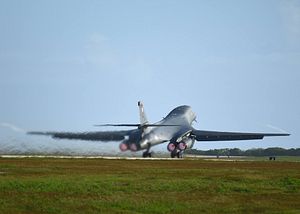The U.S. Air Force dispatched a B-1B Lancer heavy strategic bomber from Andersen Air Force Base on Guam in the Western Pacific to the Korean Peninsula, where it joined up with F-22 Raptor and F-35 stealth fighters for air combat drills on December 6.
The U.S. Air Force (USAF) and Republic of Korea Air Force (ROKAF) are currently holding a five-day air combat exercise, code named Vigilant ACE (Air Component Exercise), which is expected to conclude this Friday.
“Vigilant ACE is the allies’ annual combined exercise designed to enhance their readiness posture and capability of carrying out missions in the event of war,” the 7th US Air Force said in a press release. “The drills highlight the longstanding military partnership and enduring friendship between the two nations.”
The exercise comprises simulated precision strikes on North Korean command and control centers and missile launch sites.
The air combat drill involves around 230 USAF/ROKAF aircraft, including six USAF F-22 Raptor air superiority fighters, six conventional takeoff and landing F-35A Lightning II aircraft, and 12 U.S. Marine Corps F-35Bs capable of vertical or short takeoffs and vertical landings.
The ROKAF has dispatched F-15K Slam Eagles, KF-16C/D Block 50/52 fighter jets — a variant of the General Dynamics F-16 Fighting Falcon — and older FA-50 and F-5 aircraft to participate in the bilateral military exercise.
“Such a drill is a dangerous provocation as it is driving the tension on the Korean peninsula to the brink of a nuclear war,” North Korea’s Rodong Sinmun newspaper recently said in a commentary. “The U.S. and the South Korean puppet forces are so foolish as to run amok with such stealth fighters.”
The participation of a B-1B bomber will especially cause anxiety in Pyongyang. It sees the aircraft as a dangerous weapon capable of launching a nuclear first-strike against North Korea, although the B-1B is no longer nuclear-capable following conversion to a conventional-only delivery platform beginning in 2007.
The USAF has repeatedly dispatched B-1Bs to the Korean Peninsula to demonstrate resolve and deter aggressive North Korean actions. Pyongyang has in the past threatened to shoot down B-1Bs “even when they’re not yet inside the airspace border of our country,” as North Korean Foreign Minister Ri Yong-ho stated this September.
The B-1B is the USAFs most powerful bomber.
“The USAF’s 62 B-1B Lancers are capable of carrying up to 75,000 pounds (34,000 kilograms) of weapons — the largest payload of both guided and unguided weapons in the USAF’s inventory. Though heavily armed, the bomber can reach a top speed of Mach 1.2 and can operate at altitudes above 30,000 feet (9,100 meters),” I explained elsewhere.

































